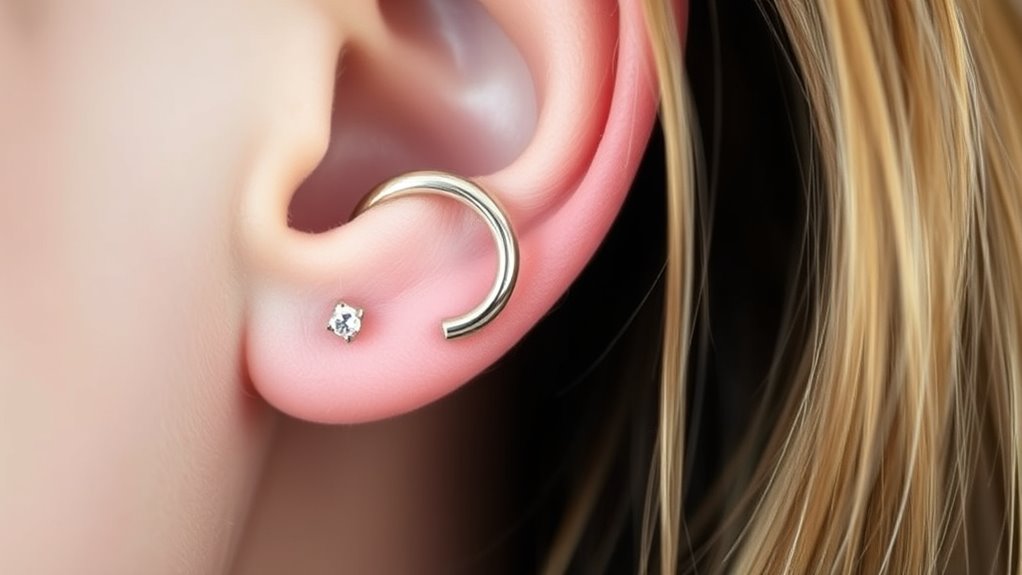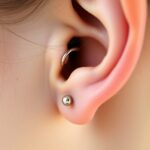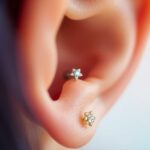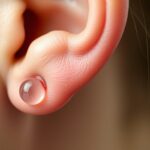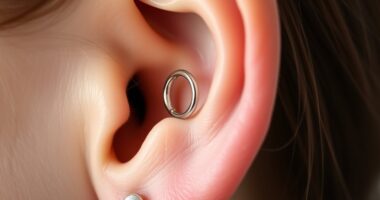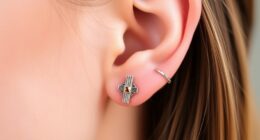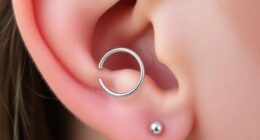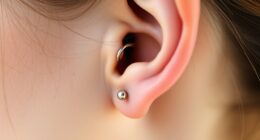Tragus and anti-tragus piercings are popular ear choices, each located on different cartilage areas. The tragus covers the ear canal, offering a bold look, while the anti-tragus is opposite the tragus, providing a subtler style. Healing times for both are longer than earlobe piercings, especially for the cartilage, and require proper care to prevent complications. If you want to explore how these piercings differ and which suits your style best, there’s more to discover below.
Key Takeaways
- The tragus is a rounded cartilage covering the ear canal, while the anti-tragus is smaller, located opposite the tragus above the earlobe.
- Tragus piercings are more prominent and suit layered jewelry, whereas anti-tragus piercings are subtler and offer a striking look.
- Healing for both takes several months to a year, with cartilage piercings generally requiring longer care.
- Proper aftercare, including saline cleaning and avoiding irritation, is crucial to prevent infections in either piercing.
- Choice depends on personal style, comfort, and willingness to undergo longer healing and care processes.
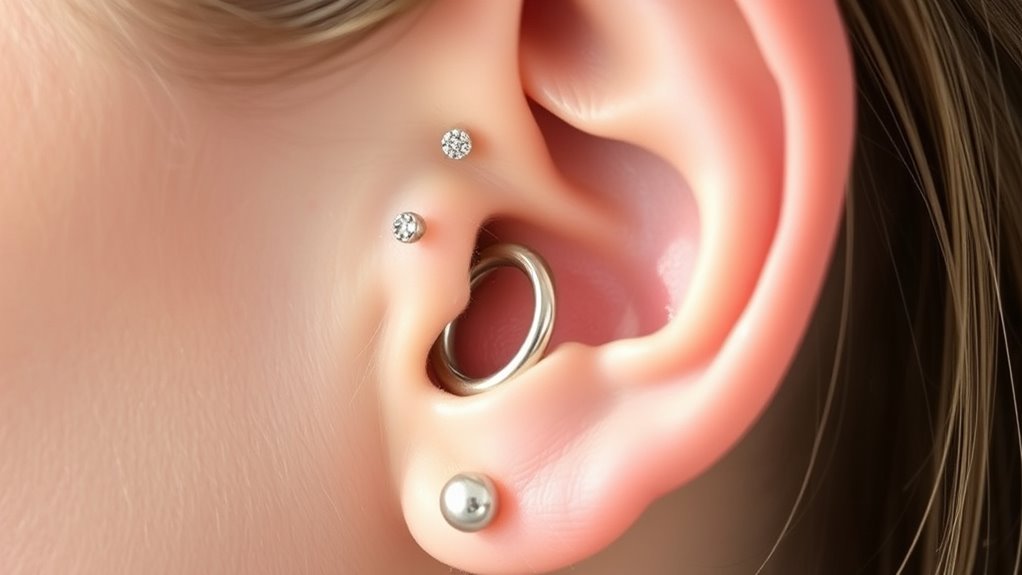
If you’re considering ear piercings, the tragus and anti-tragus are two popular options that can add a unique touch to your look. Both are situated on the ear’s cartilage, which is more rigid and takes longer to recover from than earlobe piercings. Understanding the differences between these two piercings can help you decide which suits your style and lifestyle best. The tragus is the small, rounded piece of cartilage that partially covers your ear canal, while the anti-tragus is a smaller area opposite the tragus, located just above the earlobe and across from the conch. These locations are not just aesthetic choices—they also influence the piercing process and healing time. Since both involve ear cartilage, you should be prepared for a longer piercing healing process compared to lobe piercings. Cartilage piercings are more prone to swelling, tenderness, and potential complications like infections if not properly cared for.
When getting either piercing, expect some initial discomfort, especially because cartilage is thicker and less flexible than skin. After the procedure, you’ll need to follow specific aftercare instructions to promote proper piercing healing. This includes cleaning the area regularly with saline solution, avoiding touching or twisting the jewelry, and steering clear of irritating products like alcohol or hydrogen peroxide. Because cartilage is dense and less vascular, the healing process can take anywhere from several months up to a year, depending on individual healing rates and how well you care for the piercing. You should be patient during this period and avoid changing jewelry prematurely to prevent irritation or damage.
Choosing between a tragus or anti-tragus piercing often depends on your personal style and how comfortable you are with the healing process. The tragus provides a bold statement and can be easily paired with other ear piercings for a layered look. The anti-tragus, on the other hand, offers a more subtle, yet equally striking, placement that can complement your overall ear jewelry arrangement. Both piercings require careful aftercare to ensure smooth healing and to minimize the risk of complications. If you’re attentive to hygiene and follow your piercer’s advice, you’ll enjoy your new jewelry with minimal issues. Remember, patience is key, especially with ear cartilage piercings, so give your piercing the time it needs to heal fully before swapping out jewelry or exposing it to harsh environments. Additionally, understanding the healing process can help set realistic expectations and reduce frustration during recovery.
Frequently Asked Questions
How Long Does Healing Typically Take for These Piercings?
Your healing timeline for tragus and anti-tragus piercings usually takes about 6 to 8 weeks, but it can vary depending on how well you care for them. During this period, you’ll want to keep the piercings clean to guarantee proper healing and maximize piercing longevity. Be patient, avoid touching them unnecessarily, and follow your piercer’s advice. With proper care, you’ll enjoy your new piercings for years to come.
Are There Any Specific Aftercare Tips for Each Piercing?
Imagine you’ve just gotten your tragus pierced; to keep it healthy, you should focus on piercing cleaning and swelling reduction. Gently clean the area twice daily with saline solution, avoiding harsh chemicals. For anti-tragus, avoid touching the jewelry unnecessarily, and apply cold compresses to reduce swelling. Consistent care guarantees faster healing and minimizes risks of infection. Follow your piercer’s advice closely for the best results.
Can These Piercings Be Combined With Other Ear Piercings?
Yes, you can combine tragus and anti-tragus piercings with other ear piercings. Ear stacking allows you to create stylish piercing combinations, enhancing your overall look. Just make certain your piercings are healed before adding new ones, and consult your piercer for proper placement to prevent discomfort or damage. Carefully plan your piercing combinations to achieve a cohesive, fashionable ear stack that complements your style.
What Are Common Complications or Risks Involved?
Like sailing through choppy waters, getting a tragus or anti-tragus piercing comes with risks. You face a higher infection risk if not properly cared for, and cartilage damage can occur if the piercing is done incorrectly or mishandled. Swelling, pain, or even scarring are common complications. To minimize these risks, choose a skilled piercer, keep the area clean, and follow aftercare instructions diligently.
Which Jewelry Types Are Best Suited for These Piercings?
For tragus and anti-tragus piercings, choose jewelry made from hypoallergenic earring materials like surgical steel, titanium, or niobium to reduce irritation. Opt for smooth, simple jewelry styles such as studs or hoops initially, as they’re gentle on healing tissue. As your piercings heal, you can explore more decorative options, but prioritize comfort and quality to prevent complications. Always consult your piercer for personalized jewelry recommendations.
Conclusion
No matter which piercing you choose, remember that it’s all about expressing yourself and feeling confident. The differences between tragus and anti-tragus piercings may seem small, but they can make a big impact on your style. Don’t rush your decision—take your time and pick what truly feels right. After all, it’s your body and your story, so go ahead and make it count. In the end, it’s all about finding the perfect fit for you.
Piecing together a life one day at a time, that’s me. I’m Rusty, and I love being editor-in-chief of creative piercing. It’s my passion to help others see their vision and bring it to life. When I’m not working or taking care of my family, you can find me reading a good book or eating pie (of course!).

